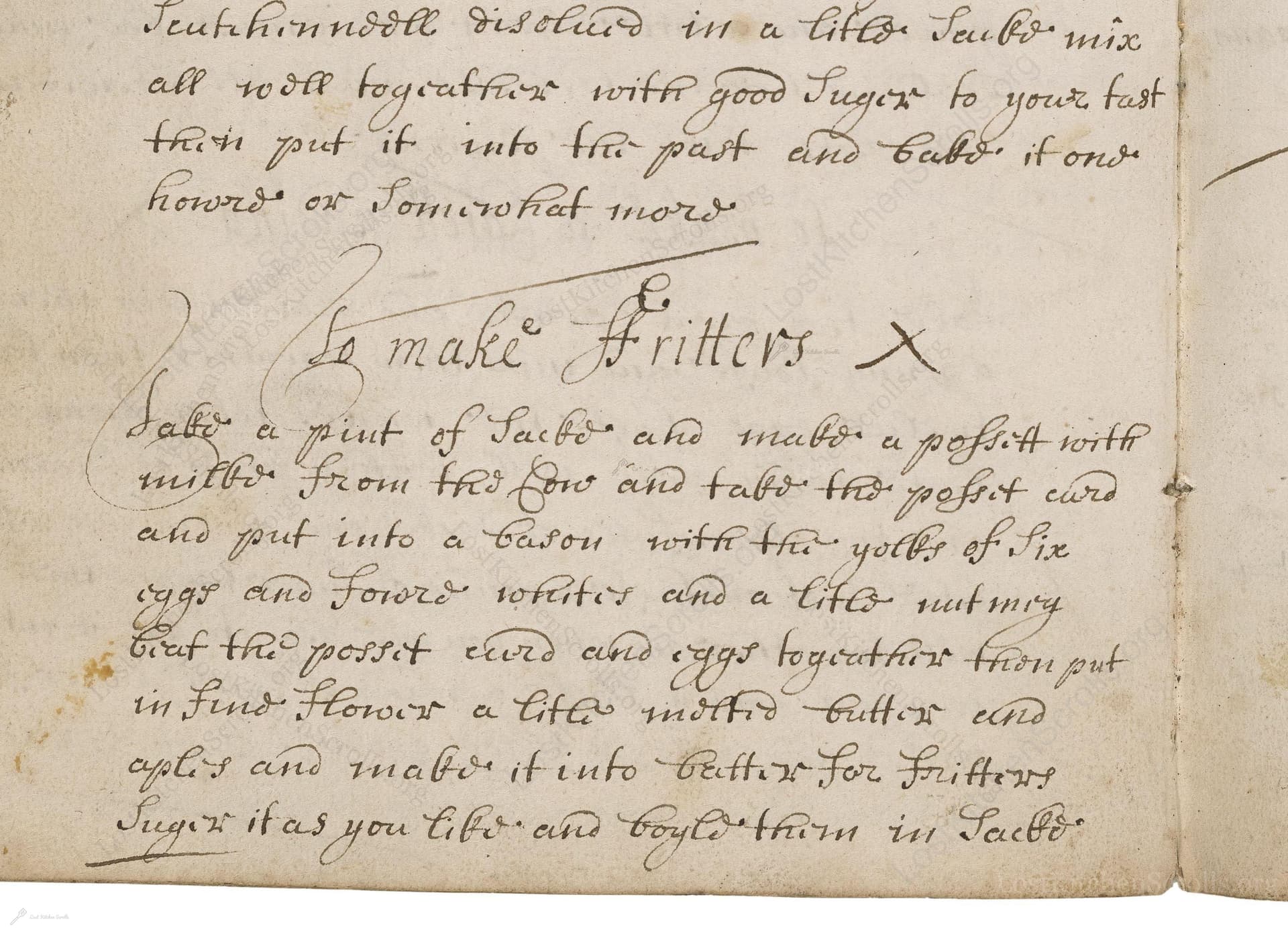To Make Fritters
From the treasured pages of Cookery book of Ann Goodenough
Written by Ann Goodenough

To Make Fritters
"Take a pint of sack and make a possit with milk from the Cow and take the possit curd and put into a bason with the yolks of Six eggs and fower whites and a little nutmeg Grat the possit curd and eggs together then put in find flower a little melted butterr and aples and make it into batter for Fritters Sugar it as you like and boyle them in Sack."
Note on the Original Text
This recipe is written in the concise, conversational style characteristic of 18th-century household manuscripts — assuming a degree of culinary knowledge on the part of the reader. Spelling is non-standard ('possit' for posset, 'bason' for basin, 'find flower' for fine flour) and quantities are approximate or omitted, as is common in pre-modern recipes. This brevity reflects a kitchen culture where cooks improvised with seasonal produce and instinctively understood texture, doneness, and flavorings.

Title
Cookery book of Ann Goodenough (1738)
You can also click the book image above to peruse the original tome
Writer
Ann Goodenough
Era
1738
Publisher
Unknown
Background
A delightful journey into the kitchens of early 18th-century England, this collection captures the flair and flavors of its time with recipes crafted by the inventive Ann Goodenough. Expect a charming medley of hearty roasts, comforting pies, and time-honored confections, perfect for those wishing to dine as they did in Georgian days.
Kindly made available by
Folger Shakespeare Library
This recipe originates from the manuscript collection of Ann Goodenough, a cook and household manager active between 1700 and 1775. The use of posset (a curdled milk drink thickened with fortified wine) shows the refinement and resourcefulness of Georgian kitchens, where leftovers and dairy by-products were transformed into delicacies. Fritters made with posset curds, eggs, and apples would have graced the tables of well-off English households during the early Georgian period, enjoyed as a warm treat or dessert — a testament to the era's taste for sweet, rich, and gently spiced fare.

In the 18th century, cooks would have used an open hearth with a trivet or frying pan placed over the coals. Milking was often direct from the cow, implied here, and possets were made in dedicated posset pots. Eggs were separated by hand, and nutmeg was grated using a small hand-held grater. Fritters might be dropped by spoonfuls into a shallow pan or small cauldron with sack wine heating gently over the fire. Utensils were mostly earthenware bowls, wooden spoons for mixing, and iron knives for chopping apples. The final fritters could be finished with sugar pounded in a mortar and pestle.
Prep Time
20 mins
Cook Time
20 mins
Servings
6
We've done our best to adapt this historical recipe for modern kitchens, but some details may still need refinement. We warmly welcome feedback from fellow cooks and culinary historians — your insights support the entire community!
Ingredients
- 2 cups whole milk
- 1 cup sweet sherry (substitute for sack wine)
- 6 egg yolks
- 4 egg whites
- Pinch freshly grated nutmeg
- 2/3 cup plain (all-purpose) flour
- 2 tablespoons melted butter
- 1–2 apples, peeled, cored, finely chopped or grated
- 2 tablespoons granulated sugar, plus extra to taste
- 1/2 cup sweet sherry (for frying, substitute for 'boiling in sack')
Instructions
- To recreate these 18th-century fritters, start by making a posset: heat 2 cups of whole milk until just boiling, then add 1 cup of sweet sherry (as a substitute for historical 'sack').
- Let the mixture curdle, then strain to collect the curds, discarding the whey.
- Place the warm posset curd into a bowl.
- Add six egg yolks and four egg whites, plus a good pinch of freshly grated nutmeg.
- Whisk everything until thouroughly combined.
- Grate in about 2/3 cup of plain flour, add 2 tablespoons of melted butter, and fold in one or two peeled, cored, and finely chopped apples.
- Stir until a loose, thick batter forms.
- Sweeten with sugar to taste.
- To fry, traditionally these were 'boiled' in sack — interpreted today as shallow-frying spoonfuls of the batter in a pan with about 1/2 cup of sherry, possibly mixed with a little butter or oil for frying.
- Fry until golden on both sides, then dust with extra sugar before serving.
Estimated Calories
350 per serving
Cooking Estimates
Preparing the batter, separating eggs, and chopping apples takes about 20 minutes. Cooking the fritters in batches takes another 20 minutes. Each fritter is rich and filling, so the recipe serves about 6 people, with each serving containing around 350 calories.
As noted above, we have made our best effort to translate and adapt this historical recipe for modern kitchens, taking into account ingredients nowadays, cooking techniques, measurements, and so on. However, historical recipes often contain assumptions that require interpretation.
We'd love for anyone to help improve these adaptations. Community contributions are highly welcome. If you have suggestions, corrections, or cooking tips based on your experience with this recipe, please share them below.
Join the Discussion
Rate This Recipe

Den Bockfisch In Einer Fleisch Suppen Zu Kochen
This recipe hails from a German manuscript cookbook compiled in 1696, a time whe...

Die Grieß Nudlen Zumachen
This recipe comes from a rather mysterious manuscript cookbook, penned anonymous...

Ein Boudain
This recipe comes from an anonymous German-language manuscript cookbook from 169...

Ein Gesaltzen Citroni
This recipe, dating from 1696, comes from an extensive anonymous German cookbook...
Browse our complete collection of time-honored recipes



